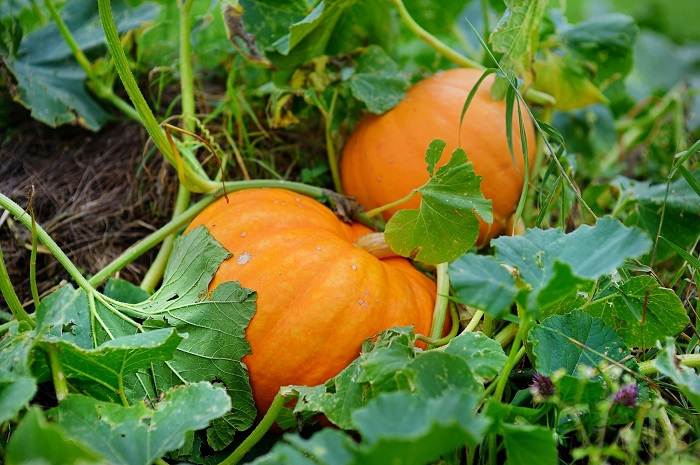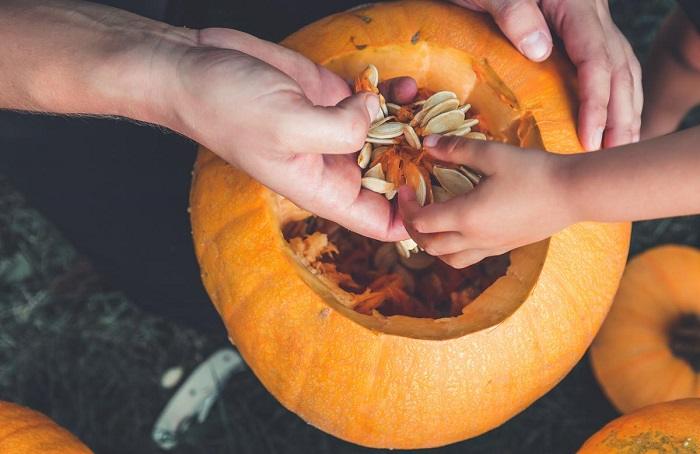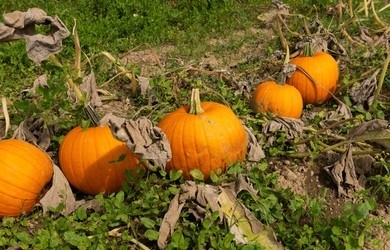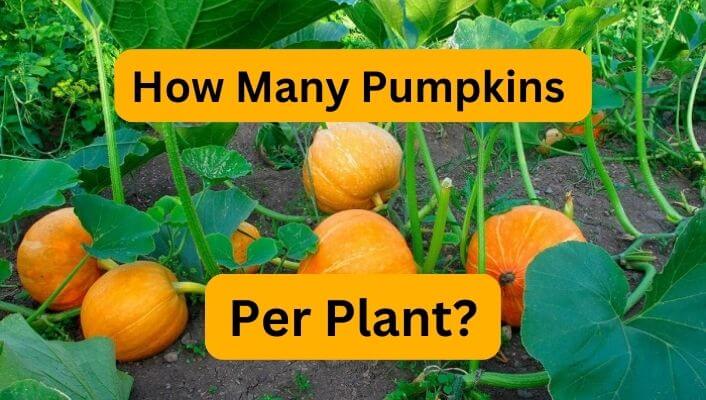Are you looking forward to a bumper pumpkin harvest this year? Wondering how many pumpkins per plant you will get? Learn how to maximize your pumpkin yield and enjoy your growing experience.
Further in the article, we will explore the different factors that affect pumpkin yield and provide tips on maximizing your pumpkin harvest.
Post Contents
How Many Pumpkins Per Plant? (Quick Answer)
The number of pumpkins per plant can vary based on various factors. On average, a healthy and well-cared-for pumpkin plant can produce around 2 to 5 pumpkins. Although, it is possible to get higher yields if the conditions and techniques are optimal.

Factors such as variety, pollination, care practices, and environmental conditions play a significant role in determining the pumpkin yield per plant. By implementing proper techniques and providing the necessary care, you can maximize the number of pumpkins you harvest from each plant.
Related Post: 7 Pumpkin Growth Stages Explained (From Seed to Harvest)
Factors Affecting Pumpkin Yield
1. Variety Selection
Different pumpkin varieties have varying growth habits and yield potentials. Some varieties are bred to produce smaller-sized pumpkins, while others are known for their ability to yield larger fruits. It’s essential to choose a variety that suits your preferences and growing conditions.
2. Pollination
Pumpkins require pollination for fruit set. Bees and other pollinators play a crucial role in transferring pollen from the male flowers to the female flowers. Inadequate pollination can result in a lower fruit set, ultimately affecting the number of pumpkins per plant.
3. Growing Conditions
Pumpkins thrive in well-drained soil that is rich in organic matter. They also require ample sunlight and consistent moisture throughout the growing season. Factors like temperature, humidity, and rainfall can influence the overall health and productivity of pumpkin plants.
4. Fertilization and Nutrient Availability
Providing proper nutrition to pumpkin plants is vital for optimal growth and yield. The application of balanced fertilizers and the availability of essential nutrients like nitrogen, phosphorus, and potassium can significantly impact the number and size of pumpkins produced.
Understanding Pumpkin Planting
To achieve a good pumpkin yield, it’s important to understand the proper techniques for planting and caring for pumpkin plants. Here are some key points to consider:
1. Timing
Pumpkins are warm-season crops that require a long growing season to mature fully. It’s crucial to plant them after the last frost date in your area when soil temperatures have warmed up to around 60°F (15°C). Starting seeds indoors or using transplants can help extend the growing season.
2. Seed Preparation

Before planting pumpkin seeds, it’s recommended to soak them in warm water for a few hours. This process can help soften the seed coat and promote faster germination.
Once soaked, the seeds can be planted at a depth of around 1 inch (2.5 cm) directly in the garden soil or in containers.
3. Spacing
Proper spacing between pumpkin plants is essential to allow for adequate air circulation and sunlight penetration. Vining pumpkin varieties generally require more space compared to bush varieties. A spacing of 3 to 5 feet (0.9 to 1.5 meters) between plants and 6 to 10 feet (1.8 to 3 meters) between rows is typically recommended.
4. Trellising and Support
For sprawling pumpkin varieties, providing support or trellising can help save space and reduce the risk of fruit rot. By training the vines to grow vertically, you can ensure better airflow and prevent the pumpkins from sitting on damp soil.
Also Read: 9 Watermelon Growing Stages: [How it Grows + Care Tips]
Tips for Maximizing Pumpkin Yield
To increase the number of pumpkins per plant and optimize your harvest, here are some helpful tips:
1. Proper Pollination
Encourage pollinators to visit your pumpkin patch by planting companion flowers that attract bees. Additionally, you can hand-pollinate the female flowers using a small brush or by transferring pollen between flowers with your fingers.
2. Soil Preparation
Prepare the soil adequately by incorporating compost or well-rotted manure before planting. This will enhance soil fertility, improve drainage, and provide a nutrient-rich environment for pumpkin growth.
3. Watering and Mulching
Pumpkins require regular watering, especially during dry spells. Apply water at the base of the plant to keep the foliage dry and discourage disease. Mulching around the plants with straw or wood chips helps retain soil moisture and suppress weed growth.
4. Pruning and Training
Removing excess vines and leaves can redirect the plant’s energy towards fruit production. Prune away any diseased or damaged foliage and train the remaining vines for better airflow and light penetration.
Importance of Proper Care and Maintenance
Giving your pumpkin plants the care and attention they need throughout the growing season is crucial for maximizing yield. Regularly monitor for pests and diseases, address any issues promptly, and provide additional support to heavy fruits to prevent them from breaking off the vine prematurely.
Common Challenges in Pumpkin Planting
Despite your best efforts, pumpkin plants may face certain challenges that can impact their yield. Here are some common issues and ways to address them:
1. Pest Infestations
Pumpkin plants can be susceptible to pests like squash bugs, cucumber beetles, and powdery mildew. Regularly inspect your plants and take appropriate measures, such as handpicking pests or using organic pest control methods, to prevent infestations.
2. Disease Outbreaks
Fungal diseases like powdery mildew and bacterial infections can affect pumpkin plants. To minimize the risk, practice crop rotation, avoid overhead watering, and apply organic fungicides if necessary.
3. Poor Fruit Set
Inadequate pollination, extreme temperatures, or nutrient deficiencies can lead to poor fruit set. Encourage pollinators, provide shade during hot periods, and ensure proper fertilization to improve fruit development.
Harvesting and Storing Pumpkins
Knowing when and how to harvest pumpkins is essential for preserving their quality and extending their shelf life. Here are some guidelines to follow:
1. Harvesting

Pumpkins are ready for harvest when the fruit has reached its full color, the skin has hardened, and the stem starts to dry.
Use sharp pruning shears or a knife to cut the stem about 2 to 4 inches (5 to 10 cm) above the fruit.
2. Curing
After harvesting, cure the pumpkins in a warm, dry location for about 10 days to toughen the skin and promote better storage.
3. Storage
Store pumpkins in a cool, dry place with good ventilation. Avoid direct contact with the ground or surfaces that can cause moisture buildup. Properly stored pumpkins can last for several months.
Frequently Asked Questions
Q1. Can I grow pumpkins in containers?
Yes, certain compact and bush varieties of pumpkins can be grown in containers. Ensure the containers have sufficient drainage and provide enough space for the roots to develop.
Q2. How long does it take for pumpkins to mature?
The time required for pumpkins to mature can vary depending on the variety. On average, it takes around 75 to 120 days from planting to harvest.
Q3. Can I save pumpkin seeds for future planting?
Yes, you can save pumpkin seeds for future planting. Allow the seeds to fully mature, scoop them out of the pumpkin, rinse off the pulp, and let them dry thoroughly before storing them in a cool, dry place.
Q4. What can I do with leftover pumpkins after Halloween?
Leftover pumpkins can be used for various purposes, such as making pumpkin puree, soups, pies, or roasted pumpkin seeds. Alternatively, you can compost them to enrich your garden soil.
Q5. Are there any companion plants that benefit pumpkin growth?
Yes, planting companion plants like marigolds, nasturtiums, or borage near your pumpkin patch can help deter pests and attract beneficial insects.
Summary
Growing pumpkins can be a rewarding experience, and with proper care, you can achieve a bountiful harvest.
Understanding the factors that affect pumpkin yield, following recommended planting techniques, and implementing effective care practices will increase your chances of obtaining a satisfactory number of pumpkins per plant.
Enjoy the process, experiment with different varieties, and savor the joy of harvesting your very own pumpkins.
Read some more articles:

